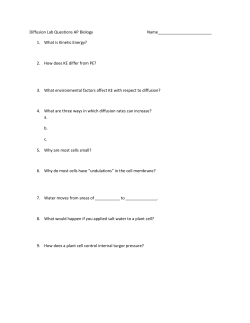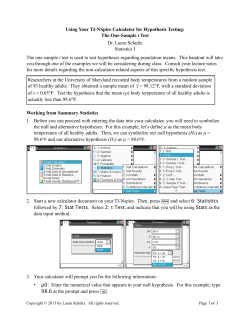
Document 153347
EXPERIMENTAL VOCABULARY & WRITING HYPOTHESES
INDEPENDENT VARIABLE (A) - the one you, the "scientist" control or change
DEPENDANT VARIABLE (B)- the one that you observe and/or measure the results after changes made
The observed outcome of the dependent variable depends on how you manipulate the independent
variable.
Hypothesis statement format: “If A (independant variable) is related to
B (dependent variable), then ____ (prediction).
The structure of a formalized hypothesis is useful because it makes you focus on two variables that may
be related. Furthermore, it forces you to make a prediction of how manipulating one variable
(independent) will affect the other variable (dependent). Let's take example from biology.
Example:
If the molecular size, (independent variable) is related to diffusion rate
(dependent variable) through a membrane,
then the smaller the molecule the faster it will pass through a membrane
(prediction).
The variables here are diffusion rate and molecular size. In the experimental design, we can manipulate
molecular size by simply selecting soluble substances of different molecular size, e.g.., iodine, glucose,
starch. The experimenter will know what the dependent variable is because it is the thing she/he
watches for results, i.e. movement of iodine (color), glucose (indicator change), and starch (indicator
change).
Another value of a formalized hypothesis is that when a scientist is given such a hypothesis, he
can be asked to design an experiment that will test the hypothesis. For example, describe an
experiment that would test the following hypothesis.
If the wave length of light is related to rate of photosynthesis, then exposing a plant to different
colors of light will produce different amounts of oxygen.
Beware! Not all "if-then" statements are hypotheses. For example, "If you warm yeast, then more gas
will be produced." This is a simple prediction, not a hypothesis! The problem with this statement is that
there is no proposition to test. What is related to what? Is temperature a variable? Is yeast a variable? I s
gas production a variable?
1
Some Hypotheses For Biology Labs
In each of the following examples, the independent variable is blue while the dependent variable
is red. These variables are identified in the “if” clause only, however, you can treat the variables
in the same way in the “then” clause. Also, each example given can be composed in a variety of
ways. For example, there is nothing incorrect with reversing the order of the independent and
dependent variables. I just do it one way for consistency. As far as the independent variable is
concerned, it can be varied by increasing, decreasing or removing it entirely. Finally, the two
variables in question do not actually have to be related. Observations from testing the
independent variable will reveal the nature of the relationship such as direct, indirect, limited, or
no relationship at all.
If ratio of surface to volume is related to the diffusion efficiency, then changing the S/V ratio
will change the rate of diffusion. {decreasing the S/V (increasing volume of a cell mass) will
decrease the rate of diffusion into a cellular mass}
If annual rainfall is related to the thickness of annual growth rings in trees, then examining wood
samples will reveal correlations in the growth rings to the historical records for rainfall in its
environment.
If various types of chlorophyll are related to food making in plants, then non-green appearing
plants such as purple plum will contain several types of chlorophyll in addition to green. {green
as well as purple pigments.}
If the presence of chlorophyll is related to food making, then starch will be found only in the
green portions of a variegated leaf.
If the presence of light is related to active photosynthesis, then portions of a leaf shaded from
light will test negative for starch.
If the wavelength of light (or concentration of carbon dioxide, or temperature) is related to rate
of photosynthesis, then varying the color of light will vary the rate of oxygen production.
If temperature is related to animal metabolism rate, then increasing ambient temperature will
increase animal metabolism (carbon dioxide gas production).
If plant availability is related to animal metabolism, then isolating plants from animals will result
in decline in animal metabolism.
If exposure time (or concentration) is related to effectiveness of disinfectants, then the longer the
exposure (or the higher the concentration) the less bacterial growth will result.
If turgor pressure is related to rigidity of herbs, then increasing the water content of cells will
result in firmer plant tissue.
2
If stomate density is related to rate of water loss, then drought resistant plants will have a lower
density of stomates on their leaves than will non drought resistant plants.
If humidity (light or temperature or wind velocity) is related to transpiration rates, then
increasing humidity will decrease water loss.
If gravity is related to root growth, then roots will always turn toward the earth regardless of a
seed's orientation.
If gravity is related to shoot growth, then shoots will always grow upward even in the absence of
light.
If salinity (or temperature) is related to hatching of brine shrimp, then the greater the salt
concentration, the higher the hatching rate.
If temperature (or pH or quantity of substrate) is related to enzyme activity, then increasing the
temperature will increase the products of an enzymatic reaction.
3
© Copyright 2025





















